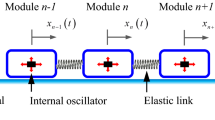Abstract
This paper presents a novel human–manipulator interface which copies the hand motion to control a manipulator. In the proposed interface, an inertial measurement unit is used to measure the orientation of the human hand, and a 3D camera is employed to locate the human hand using the Camshift algorithm. Although the position and the orientation of the human can be obtained from two sensors, the measurement errors increase over time due to the noise of the devices and the tracking errors. Therefore, particle filter and Kalman filter are used to estimate the position and the orientation of the human hand. Due to the limitations of the perceptive and the motor, human operator cannot accomplish the high-precision manipulation without any assistance. An over-damping method is employed to assist the operator to improve the accuracy and reliability in determining the postures of the manipulator. The human–manipulator interface system was experimentally tested in a lab environment, and the results indicate that such an interface can successfully control a robot manipulator even when the operator is not an expert.








Similar content being viewed by others
References
Cho K-B, Lee B-H (2012) Intelligent lead: a novel HRI sensor for guide robots. Sensors 12(6):8301–8318
Mitsantisuk C, Katsura S, Ohishi K (2010) Force control of human-robot interaction using twin direct-drive motor system based on modal space design. IEEE Trans Ind Electron 57(4):1338–1392
Ando T, Tsukahara R, Seki M (2012) A hapic interface “Force Blinker 2” for navigation of the visually impaired. IEEE Trans Ind Electron 59(11):4112–4119
Hirche S, Buss M (2012) Human-oriented control for haptic teleoperation. Proc IEEE 100(3):623–647
Kiguchi K, Kariya S, Watanabe K (2003) An exoskeletal robot for human elbow motion support-sensor fusion, adaptation, and control. IEEE Trans Syst Man Cybern Part B Cybern 31(3):353–361
Kofman J, Wu X, Luu T et al (2005) Teleoperation of a robot manipulator using a vision-based human-robot interface. IEEE Trans Ind Electr 52(5):1206–1219
Siddharth V (2004) Vision-based markerless 3D human-arm tracking. M.A.Sc. Thesis, Department of Mechanical Engineering, University of Ottawa, Ottawa, Canada, pp 77–165
Suau X, Ruiz-Hidalgo J, Casas JR (2012) Real-time head and hand tracking based on 2.5D Data. IEEE Trans Multim 14(3):575–585
Ma Y, Mao ZH, Jia W et al (2011) Magnetic hand tracking for human-computer interface. IEEE Trans Magn 47(5):970–973
Khezri M, Jahed M (2011) A neuro-fuzzy inference system for semg-based identification of hand motion commands. IEEE Trans Ind Electron 58(5):1952–1960
Varkonyi-Koczy AR, Tusor B (2011) Human-computer interaction for smart environment applications using fuzzy hand posture and gesture models. IEEE Trans Instrum Meas 60(5):1505–1514
Ueda E, Matsumot Y, Imai M et al (2003) A hand-pose estimation for vision-based human interfaces. IEEE Trans Ind Electron 50(4):676–684
Zhang J, Knoll A (2003) A two-arm situated artificial communicator for human-robot cooperative assembly. IEEE Trans Ind Electron 50(4):651–658
Du G, Zhang P (2015) A markerless human-robot interface using particle filter and Kalman filter for dual robots. IEEE Trans Ind Electron 62(4):2257–2264
Kofman J, Verma S, Xianghai W (2007) Robot- manipulator teleoperation by markerless vision-based hand-arm tracking. Int J Optomech 1(3):331–357
Guanglong D, Zhang P, Li D (2014) Human-manipulator interface based on multisensory process via Kalman filters. IEEE Trans Ind Electron 61(10):5411–5418
Semwal, Vijay B, Gora Chand N (2015) Toward Developing a computational model for bipedal push recovery-a brief. Sens J IEEE 15(4):2021–2022
Semwal, Vijay B (2015) Biologically-inspired push recovery capable bipedal locomotion modeling through hybrid automata. Robot Auton Syst 70:181–190
Hidayatullah P (2011) CAMSHIFT improvement on multi-hue object and multi-object tracking. 3rd European Workshop on Visual Information Processing. Paris 2011, pp 143–148
Zhang P, Guanglong D, Li D (2014) A novel human-robot interface using hybrid sensors with Kalman filters. Ind Robot 41(6):585–595
Guanglong D, Zhang P (2014) Online serial manipulator calibration based on multisensory process via extended Kalman and particle filters. IEEE Trans Ind Electron 61(12):6852–6859
Xiaoping Y, Eric R B, Robert B M (2008) A simplified quaternion-based algorithm for orientation estimation from earth gravity and magnetic field measurements. IEEE Trans Instrum Meas 57(3):638–650
Man Ho K, Suk L, Kyung Chang L (2010) Kalman predictive redundancy system for fault tolerance of safety-critical system. IEEE Trans Ind Inf 6(1):46–53
Kalman RE (1960) A New approach to linear filtering and prediction problems. ASME J Basic Eng 82(1):35–45
Kit Yan C, Yiu CKF, Dillon (2012) Enhancement of speech recognitions for control automation using an intelligent particle swarm optimization. IEEE Trans Ind Inf 8(4):869–879
Liu JS, Chen R (1998) Sequential Monte Carlo methods for dynamic systems. J Am Stat Assoc 93(443):1032–1044
Yuan C, Druzdzel MJ (2007) Theoretical analysis and practical insightson importance sampling in Bayesian networks. Int J Approx Reason 46(2):320–333
Won SP, Melek WW, Golnaraghi F (2011) Fastening tool tracking system using a Kalman filter and particle filter combination. Meas Sci Technol 22:108–119
Won SP, Melek WW, Golnaraghi F (2009) A fastening tool trackingsystem using an IMU and a position sensor with Kalman filters and a fuzzyexpert system. IEEE Trans Ind Electron 56(5):1782–1792
Antonelli G, Chiaverini S, Fusco G (2003) A new on-line algorithm for inverse kinematics of robot manipulators ensuring path tracking capability under joint limits. IEEE Trans Robot Autom 19(1):162–167
Glas DF, Kanda T, Hagita N (2012) Teleoperation of multiple social robots. IEEE Trans Syst Man Cybern 42(3):530–544
Marin R, Sanz PJ, Wirz R (2005) A multimodal interface to control a robot arm via the web: a case study on remote programming. IEEE Trans Ind Electron 52(6):1506–1521
Acknowledgments
Project supported by “National Undergraduate Innovative and Entrepreneurial Training Program (No:201610561127)” and “National Natural Science Foundation of China (Grant No. 61403145)”.
Author information
Authors and Affiliations
Corresponding author
Rights and permissions
About this article
Cite this article
Du, G., Lei, Y., Shao, H. et al. A human–robot interface using particle filter, Kalman filter, and over-damping method. Intel Serv Robotics 9, 323–332 (2016). https://doi.org/10.1007/s11370-016-0202-9
Received:
Accepted:
Published:
Issue Date:
DOI: https://doi.org/10.1007/s11370-016-0202-9




